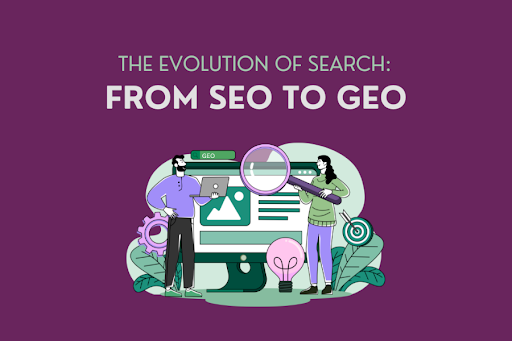The Evolution of Search: From SEO to GEO
The digital marketing ground beneath your feet is shifting fast. Search is no longer just Google; it’s AI tools like ChatGPT, Perplexity, and Claude.
We’re no longer relying on search engines alone. We’re also turning to generative AI to find information, solutions, and answers, and the change has major implications for search optimization.
Let’s be clear: This is not a remix of SEO. It is a revolution.
Generative Engine Optimization (GEO) is the only play that matters in an AI-native world, because it molds how AI sees and trusts your brand, transforming visibility into authority.
What Is Generative Engine Optimization (GEO)?
GEO tweaks keywords and forces your brand into the answer box of AI tools. This shift requires an entirely different mindset and method:
Crafting AI-readable content built around authority, expertise, and clarity
Embedding structure such as schema markup, Q&As, lists, and definitions to allow seamless AI extraction
Aligning with E‑E‑A‑T: experience, expertise, authoritativeness, and trustworthiness, which are essential for both AI and search engines
Here’s the reality: If AI can’t easily extract your content, it will choose someone else’s. GEO ensures it chooses you and cites you.
How GEO Works Under the Hood
Let’s break down how AI engines operate:
Interpret user intent in natural language
Crawl and index sources
Synthesize a coherent answer from multiple citations
Display a final, sourced response in real-time
That citation is where GEO makes its mark. If your content isn’t optimized to be pulled, it won't be seen, and it definitely won’t be cited.
A 2023 study showed optimized content boosted AI citations by up to 40%. The takeaway? Structure and credibility aren’t nice-to-haves, but performance drivers.
SEO vs. GEO: The Stakes Have Changed
SEO once meant ranking high with keywords, backlinks, and meta tags. That formula still has value, but it no longer owns the game. GEO changes the goal from visibility in SERPs to being the answer in AI-generated responses.
While SEO rewards technical setup and keyword density, GEO demands content that’s structured, credible, and machine-readable. Schema, Q&A blocks, and E‑E‑A‑T are now baseline requirements, not enhancements.
The shift is deeper than tactics. SEO tracks clicks. GEO tracks citations. If your content isn’t cited, it’s not trusted. And if it’s not trusted, it won’t be seen.
Let’s be clear. GEO isn’t an upgrade; it’s a survival requirement. Brands built only for Google will be left behind as decision-making moves inside AI engines.
And while AI can enhance visibility, it can also damage it. Brands relying on low-quality AI-generated content risk losing trust, citations, and long-term relevance. So you need to be intentional. AI will just as easily ignore your content as amplify it.
Five GEO Action Pillars: Your Tactical Playbook
1. Answer-First Structure
Don’t bury the lead. Lead with answers.
Use FAQ blocks, listicles, and definition sections to create snippet-ready content.
Include schema markup: FAQPage, QAPage, Article, etc., or plug-ins on the backend to support schema markup.
Deliver value in under 300 characters, wherever possible.
If AI can’t parse your content in seconds, it’ll move on without you.
2. GEO-Focused Keyword Strategy
Search is now conversational. Your strategy should be too.
Prioritize natural-language queries like, “How do I optimize for AI search?”
Map content clusters, not just keywords. This helps dominate full topic spheres, not just fragments.
If your keywords aren’t phrased like your audience speaks, AI won’t connect the dots.
3. Demonstrate E‑E‑A‑T
AI doesn’t just reward content; it rewards credible content, much like Google does.
Add authorship, credentials, and linked sources.
Reference research, case studies, and reputable publications.
Timestamp and update content regularly, AI favors freshness and recency.
In simple words: No proof = no trust = no citation. It’s that simple.
4. Technical SEO That’s Machine Ready
Your site architecture now feeds AI models, not just search crawlers.
Create a llms.txt file to define what AI can crawl.
Use structured metadata (JSON-LD, OpenGraph, schema).
Streamline code for token efficiency with AIs that love lean text and clear logic.
If your site’s not AI-readable, it’s AI-irrelevant.
5. Measure GEO Impact
You can’t improve what you don’t measure.
Manually search your brand on ChatGPT, Perplexity, and Gemini, etc, while noting citations and inclusion frequency.
Use zero-click analytics tools to detect AI-driven traffic surges.
A/B test structured vs. unstructured content; track performance shifts over 30–60 days.
If your content doesn’t show up when it matters, it might as well not exist.
Advanced Tactics: Stay Ahead of the AI Curve
Monitor brand mentions in AI: What’s missing? What’s wrong? Use those blind spots to update and reclaim relevance.
Stay ethical: Avoid manipulative prompts or token tactics. AI is getting smarter and remembers who played fair.
Leverage PR for GEO: High-authority mentions (in media, podcasts, or academia) now fuel AI trust signals, not just human ones.
You’re not just optimizing for search, you’re training the machines that shape perception.
The Bottom Line
GEO is no longer optional. As search becomes generative and AI-led, brands optimized solely for Google risk falling out of sight when it matters most.
Don’t wait for your traffic to vanish before you act. Start auditing your content for GEO-readiness now, or risk becoming invisible at the moment your buyers need you most.
Need help with your content strategy in an ever-changing search ecosystem? SpotOn is here to help. Talk to us about our research, audit, and strategy sessions to evaluate your content and implement changes to help your brand stay visible in search. Contact us today to learn more about our SEO and GEO services.

